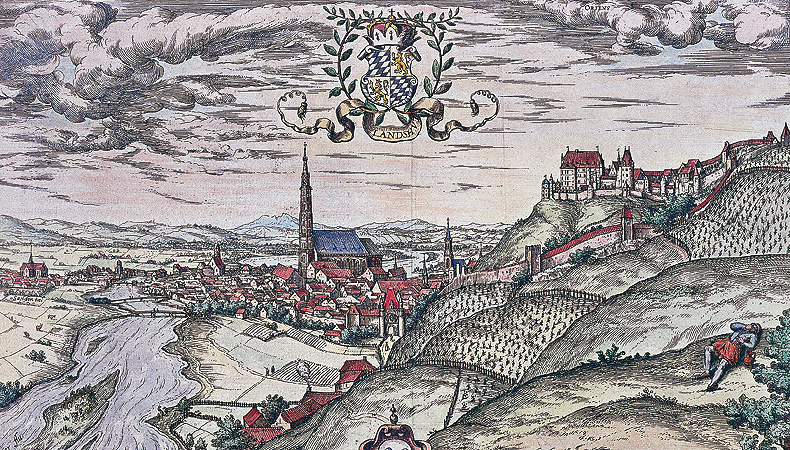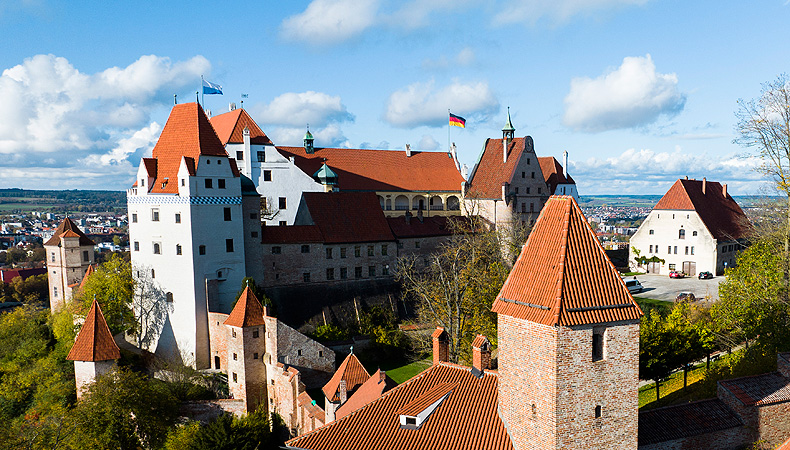Trausnitz Castle > Chronological table
Main information:
Trausnitz Castle

Chronological table
1150-1200
"Lanthut, Landeshute" first mentioned in documents
1180-1183
Duke Otto I von Wittelsbach
1183-1231
Duke Ludwig I, the "Kelheimer"
1231-1253
Duke Otto II, the Illustrious
1204
Building of the castle and the town begins (according to Hermann von Niederaltaich) and extension continues until around 1235.
The first sections of Trausnitz Castle to be built are the Wittelsbach Tower, the gateway building, the Great Hall and the castle chapel.
1255-1340
After the first Bavarian land partition in 1255, the castle becomes the residence and seat of government of the duchy of Lower Bavaria
Duke Heinrich XIII (1253-1290); Old Knight's Hall, Bower?,
fortifications
Duke Otto III (1290-1312; together with Ludwig III and Stephan I)
Duke Otto IV (1312-1334)
Duke Johann I, the Child (1334-1340)
1340-1392
Reunification of the Bavarian duchies
Ludwig IV, the Bavarian, Roman Emperor from 1328 (1340-1347)
Stephan II (1347-1375)
Friedrich (1375-1393)
1392-1503
After the 3rd Bavarian land partition in 1392, the castle became the residence and seat of government of the dukes of Bavaria-Landshut
Heinrich XVI the Rich (1393-1450)
Ludwig IX the Rich (1450-1479)
Georg the Rich (1479-1503)
New Bower, New Knights' Hall, Princes' Building, addition of a second upper floor, kitchen building, Old Tower Terrace, raising of the gateway building, upper floors and roof of the Wittelsbach Tower, Deep Well, raising of the ring wall, new fortifications.
1503
Landshut War of Succession
Lower Bavaria falls to the Dukes of Bavaria-Munich, Munich becomes the seat of government; succession is regulated by the primogeniture law of Duke Albrecht IV in 1506 in favour of the first-born son.
1508-1550
Duke Wilhelm IV
1516-1545
Duke Ludwig X, brother of Wilhelm IV, governor of Landshut and Straubing, in residence in Landshut
Furnishing of the rooms, vaulting of the chapel, St George Knights' Hall, two-storey passageway between the court kitchen and New Knights' Hall, tower terrace and tower terrace stairs, Chaplain's Building (Pfaffenstöckl), wine cellar
1536-1543: The Landshut Town Residence is built
1545-1550
Landshut is the residence of Prince Albrecht (V)
1550-1579
Duke Albrecht V
New castellan's apartment, completion of the wine cellar
1568-1579
Court of Prince Wilhelm (V)
Major extensions, functional buildings in the outer courtyard, pleasure gardens, pavilion, Italian Extension with Fools' Staircase, arcade passage, painting of the rooms
1579-1597
Duke Wilhelm V
1598-1651
Duke Maximilian I, elector from 1623
Swedish occupation in 1632 (King Gustav Adolf) and 1634 (Duke Bernhard von Weimar); removal of the functional buildings (Schwedenwiese / Swedish Meadow); explosion disaster
1651-1679
Elector Ferdinand Maria
Improvement and extension of the wall paintings
1680-1799
Electors
Max Emanuel (1680-1726),
Karl Albrecht (1726-1745,
Emperor Karl VII from 1742),
Max III Joseph (1745-1777),
Karl Theodor (1777-1799)
In 1703 Trausnitz Castle became a barracks and internment camp, from 1762-1771 a manufactory of woollen goods and silk, then the bursary registry (state archives).
Division of the White Hall, removal of further functional buildings from the outer courtyard, fortifications fall into ruins
1799-1918
Elector Max IV Joseph (1799-1825, King of Bavaria from 1806),
King Ludwig I (1825-1848),
King Maximilian II (1848-1864),
King Ludwig II (1864-1886),
Prince Regent Luitpold (1886-1912),
King Ludwig III (1912-1918)
The castle is a military hospital in 1806 and 1813, a cholera hospital in 1831, and in 1866 a military hospital again.
Initial preservation and restoration work in 1849; accommodation for Ludwig II on the 2nd upper floor, Chapel redesigned in the romantic style 1869-1873
seit 1918
Free State of Bavaria
Initially administered by the State Archives, subsequently by the Bavarian Palace Administration
21.10.1961
The interior of the Princes' Building is destroyed. Preservation and restoration work is begun immediately.
1966
The Princes' Building is handed over to the Landshut State Archives
1968 / 1970
Opening of the restored ground floor rooms and the Chapel
Opening of the restored upper floor rooms
1975
Restoration of the White Hall and opening of the castle restaurant
2004
Opening of the new entrance and cash desk area on the ground floor of the former Ladies' Apartments (Damenstock)
Opening of the Kunst- und Wunderkammer (Chamber of Art and Curiosities) in the Damenstock as a branch of the Bavarian National Museum Munich


Facebook Instagram YouTube